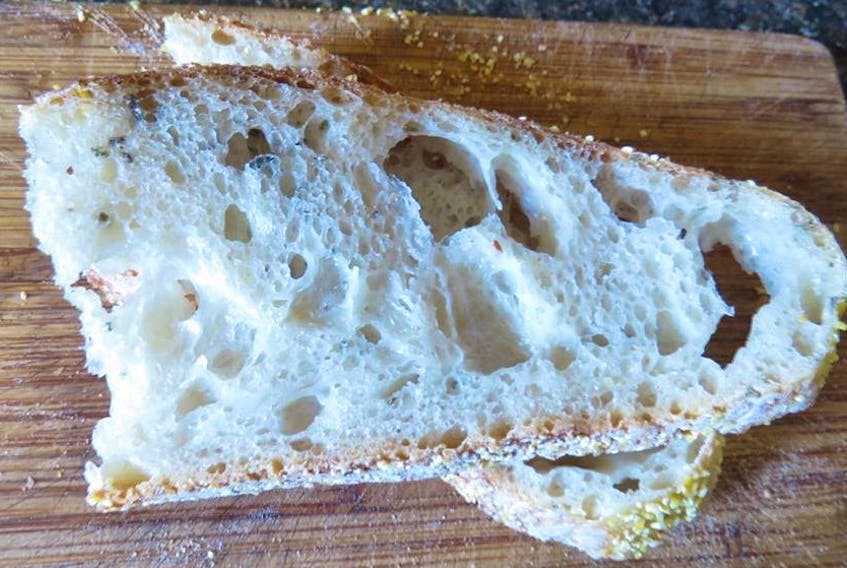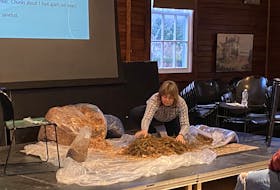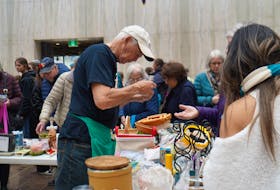This recipe was recommended by a reader, who referred me to a story written by Susan Selasky for the Detroit Free Press in April of this year.
It’s a bit like a chain letter. Selasky’s article referred to a column Mark Bittman had written for the New York Times. The recipe is legendary, with many variations, and I’m glad I’ve finally tried it.
If you’re running low on yeast, this recipe is for you. It calls for a mere 1 mL (¼ tsp) of yeast per loaf.
If you have pain or weakness that makes kneading difficult, it’s for you. You really do not have to knead it. The long slow action of the yeast produces enough carbon dioxide to make the dough rise without the mechanical action of kneading.
If you like robust, crusty bread, it’s also for you. Although you might guess that a loaf made without kneading would be flat and compact, you might be surprised to see the rise and the golden chewy crust that develops. I posted pictures at Facebook.com/IslandGusto.
If you don’t require instant gratification (many of us aren’t going anywhere these days anyway) it’s for you. It takes time for the yeast to multiply and then work its magic, filling the dough with bubbles.
The basic recipe contains just flour, yeast, salt and water, but Selasky says that it can be jazzed up with additions such as herbs, cheese or olives. I made it using rosemary, on the recommendation of the reader who contacted me. We enjoyed it fresh and warm with butter and toasted.
I baked the loaf in a Paderno Dutch oven with cover. As I didn’t know the size of it in either quarts or litres, I used a large measuring cup to fill it with water and found it held six quarts. That was large enough, and although the recipe suggests using cast iron, enamel or ceramic, the bread baked perfectly in the heavy stainless steel.
No-Knead Bread with Rosemary
Adapted from Jim Lahey, Sullivan Street Bakery, Manhattan
- 750 mL (3 cups) all purpose or bread flour plus more for dusting
- 1 mL (¼ tsp) instant yeast
- 6 mL (1¼ tsp) salt
- 25 mL (2 tbsp) minced fresh rosemary
- 405 mL (1⅝ cups) water
- cornmeal or wheat bran as needed
In a large bowl combine flour, yeast, salt and rosemary. Add water and stir until blended; dough will be shaggy and sticky.
Cover the bowl with plastic wrap. Let the dough rest at least 12 hours, preferably about 18, at warm room temperature, about 20 C (70 F).
The dough is ready when its surface is dotted with bubbles. Lightly flour a work surface and place the dough on it; sprinkle it with a little more flour and fold it over on itself once or twice. Cover it loosely with plastic wrap and let it rest about 15 minutes.
Using just enough flour to keep the dough from sticking to the work surface or your fingers, gently and quickly shape the dough into a ball.
Generously coat a cotton towel (not terrycloth) with flour wheat bran or cornmeal; put the dough seam side down on the towel and dust it with more flour, bran or cornmeal. Cover it with another towel and let it rise for about two hours. When it is ready, the dough will be more than double in size and will not readily spring back when poked with a finger.
At least a half hour before the dough is ready, heat the oven to 230 C (450 F). Put a 6- to 8-quart heavy covered pot (cast iron, enamel or ceramic) in the oven as it heats. Make sure the pot is oven safe to that temperature.
When the dough is ready, carefully remove the pot from the oven. Slide your hand under the towel and turn the dough over into the pot, seam side up; it may look like a mess, but that is OK. Shake the pan once or twice if the dough is unevenly distributed; it will straighten out as it bakes.
Cover the pot with the lid and bake 30 minutes, then remove the lid and bake another 15 to 30 minutes, until the loaf is beautifully browned. Remove from the oven and cool on a rack.
Margaret Prouse, a home economist, can be reached by email at [email protected].









